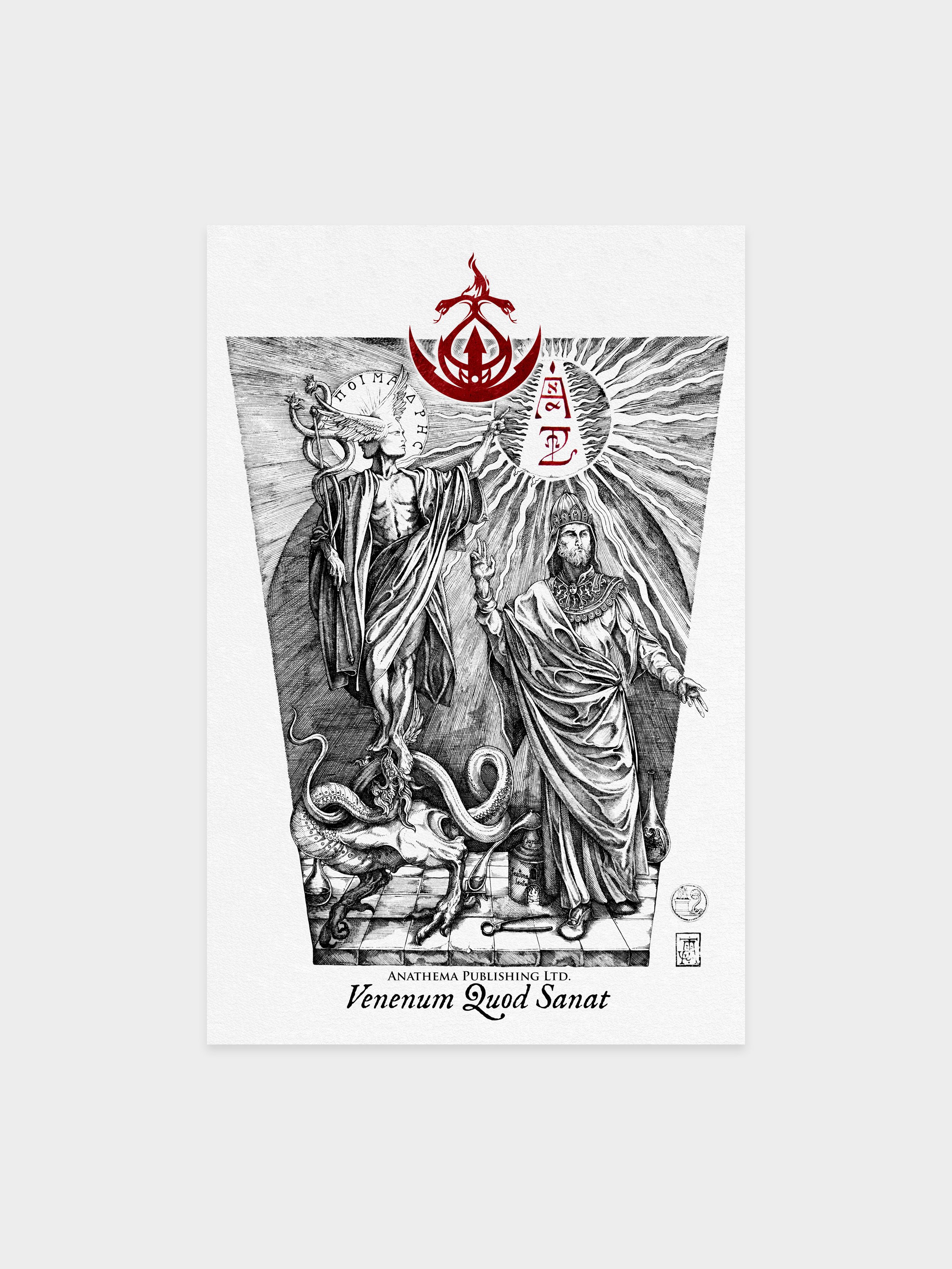 Image 1 of 1
Image 1 of 1


Venenum Quod Sanat
[Exclusive Promo Print / Originally printed in 2021. Profits made from the sale of these prints helped us fund the relocation of our home and operation to another city.]
by José Gabriel Alegria Sabogal
Original Retail Prices: $60 CAD
This Art Print depicts the mythical personages of Hermes Trismegistus & Poimandres, of the famous Corpus Hermeticum.
Hermes and Poimandres
Poimandres is the first treatise of the Corpus Hermeticum; it is also the name of the supernatural being that offers Hermes Trismegistus the opening revelation from the works attributed to him. He presents himself as “the thought of the Supreme Power,” and so, we dare to assert that this incarnation of divine thought could be compared to what later western occultism developed as the “Holy Guardian Angel.”
This divine being is depicted mostly with aspects attributed to the classical god Hermes – namely in the holding of a caduceus and with winged feet. However, we have chosen to depict him as many-faced as well, as such depictions may have existed in late antiquity during the time of Peisistratos (561-528 B.C.E.). Here, such faces are not fully visible, partly obscured by wings, in the manner of the seraphim, hinting at the ‘angelic’ nature of such a creature. Hermes stands on a dragon inspired by the Ripley Scroll (British Library Sloane MS 2523B) and points towards the sun – a recurrent allegory in the hermetic dialogues. Inside the sun is our monogram of Azoth, composed of the first and last letters of the Latin, Greek, and Hebrew alphabets.
The sage Trismegistus is depicted as he appears on the floor of the Cathedral of Siena, or in the engravings by Matthäus Merian. His image is certainly not the one of an Egyptian sage as we would imagine it nowadays, but rather it is based on the way in which renaissance artists imagined the wise men of the East – in an eclectic manner. The alchemical vessels in the floor are based on the ones in the Oratorium-laboratorium of Heinrich Khunrath’s Amphitheatrum Sapientiae Aeternae (1609 C.E.) and display the motto “festina lente” indicating the patience and persistence required for the alchemical work. In alchemy, Hermes Trismegistus always played the role of an authoritative figure, and not only as an author, but also as being identified with mercury or quicksilver – ways in which the literal and allegorical become blurred.
“…the Philosophers have ascribed to quicksilver not only the beginning of their art, but also the middle and the perfect end.” —Splendor Solis, fol.42v.
And so, such a substance was believed to be key for achieving alchemical gold, just as the teachings of the master identified with it.
But Hermes Trismegistus needs no introduction for our dear public; the thrice great was also identified with the Egyptian god Thot (Cicero, De Natura Deorum III. 56) and so, the idea that he was the patron of hieroglyphs, inspired the wonderful tradition of alchemical images that aimed to encode divine knowledge just as ancient Egyptian writing did. From the personal experience I had working with Anathema’s editor and author, I knew the importance that Trismegistus played for this endeavour, as his principles were always at the heart of it.
It is also worthy to mention that the Poimandres is a book that shows impressive similarities with some Gnostic cosmogonies, like a world created by a Demiurge, with seven rulers or Archons, and the wonderful vision of a cosmic serpent on which the whole universe rests. Such parallels have been studied by scholars such as Richard Reitzenstein, and they have also been confirmed by the fact that a treatise from the Corpus was found within the Nag-Hammadi Library. This is our humble contribution to celebrate such a long and rich cultural tradition, which has been the foundation of a considerable part of western esotericism.
—José Gabriel Alegría Sabogal
Bibliography
Reitzenstein, Richard Poimandres; studien zur griechisch-ägyptischen und frühchristlichen literatur. Leipzig: B.G. Teubner, 1904.
Kirfel, Willibald Die dreiköpfige Gottheit: Archäologisch-ethnologischer Streifzug durch die Ikonographie der Religionen. Bonn: Ferdinand Dümmlers Verlag, 1948.
Textos Herméticos, introducción, traducción y notas de Xavier Renau Nebot. Madrid: Gredos, 1999.
Godwin, Joscelyn et. Al. Splendor Solis: The World’s Most Famous Alchemical Manuscript. London: Watkins, 2019.
11” X 16.75” - Printed on exquisite, thick, and highly-textured Hahnemuhle William Turner 310 GSM (cold-pressed 100% cotton) paper-carton.
Limited to 100 hand-numbered copies (printed in two distinct phases of 50 copies each).
[Exclusive Promo Print / Originally printed in 2021. Profits made from the sale of these prints helped us fund the relocation of our home and operation to another city.]
by José Gabriel Alegria Sabogal
Original Retail Prices: $60 CAD
This Art Print depicts the mythical personages of Hermes Trismegistus & Poimandres, of the famous Corpus Hermeticum.
Hermes and Poimandres
Poimandres is the first treatise of the Corpus Hermeticum; it is also the name of the supernatural being that offers Hermes Trismegistus the opening revelation from the works attributed to him. He presents himself as “the thought of the Supreme Power,” and so, we dare to assert that this incarnation of divine thought could be compared to what later western occultism developed as the “Holy Guardian Angel.”
This divine being is depicted mostly with aspects attributed to the classical god Hermes – namely in the holding of a caduceus and with winged feet. However, we have chosen to depict him as many-faced as well, as such depictions may have existed in late antiquity during the time of Peisistratos (561-528 B.C.E.). Here, such faces are not fully visible, partly obscured by wings, in the manner of the seraphim, hinting at the ‘angelic’ nature of such a creature. Hermes stands on a dragon inspired by the Ripley Scroll (British Library Sloane MS 2523B) and points towards the sun – a recurrent allegory in the hermetic dialogues. Inside the sun is our monogram of Azoth, composed of the first and last letters of the Latin, Greek, and Hebrew alphabets.
The sage Trismegistus is depicted as he appears on the floor of the Cathedral of Siena, or in the engravings by Matthäus Merian. His image is certainly not the one of an Egyptian sage as we would imagine it nowadays, but rather it is based on the way in which renaissance artists imagined the wise men of the East – in an eclectic manner. The alchemical vessels in the floor are based on the ones in the Oratorium-laboratorium of Heinrich Khunrath’s Amphitheatrum Sapientiae Aeternae (1609 C.E.) and display the motto “festina lente” indicating the patience and persistence required for the alchemical work. In alchemy, Hermes Trismegistus always played the role of an authoritative figure, and not only as an author, but also as being identified with mercury or quicksilver – ways in which the literal and allegorical become blurred.
“…the Philosophers have ascribed to quicksilver not only the beginning of their art, but also the middle and the perfect end.” —Splendor Solis, fol.42v.
And so, such a substance was believed to be key for achieving alchemical gold, just as the teachings of the master identified with it.
But Hermes Trismegistus needs no introduction for our dear public; the thrice great was also identified with the Egyptian god Thot (Cicero, De Natura Deorum III. 56) and so, the idea that he was the patron of hieroglyphs, inspired the wonderful tradition of alchemical images that aimed to encode divine knowledge just as ancient Egyptian writing did. From the personal experience I had working with Anathema’s editor and author, I knew the importance that Trismegistus played for this endeavour, as his principles were always at the heart of it.
It is also worthy to mention that the Poimandres is a book that shows impressive similarities with some Gnostic cosmogonies, like a world created by a Demiurge, with seven rulers or Archons, and the wonderful vision of a cosmic serpent on which the whole universe rests. Such parallels have been studied by scholars such as Richard Reitzenstein, and they have also been confirmed by the fact that a treatise from the Corpus was found within the Nag-Hammadi Library. This is our humble contribution to celebrate such a long and rich cultural tradition, which has been the foundation of a considerable part of western esotericism.
—José Gabriel Alegría Sabogal
Bibliography
Reitzenstein, Richard Poimandres; studien zur griechisch-ägyptischen und frühchristlichen literatur. Leipzig: B.G. Teubner, 1904.
Kirfel, Willibald Die dreiköpfige Gottheit: Archäologisch-ethnologischer Streifzug durch die Ikonographie der Religionen. Bonn: Ferdinand Dümmlers Verlag, 1948.
Textos Herméticos, introducción, traducción y notas de Xavier Renau Nebot. Madrid: Gredos, 1999.
Godwin, Joscelyn et. Al. Splendor Solis: The World’s Most Famous Alchemical Manuscript. London: Watkins, 2019.
11” X 16.75” - Printed on exquisite, thick, and highly-textured Hahnemuhle William Turner 310 GSM (cold-pressed 100% cotton) paper-carton.
Limited to 100 hand-numbered copies (printed in two distinct phases of 50 copies each).

